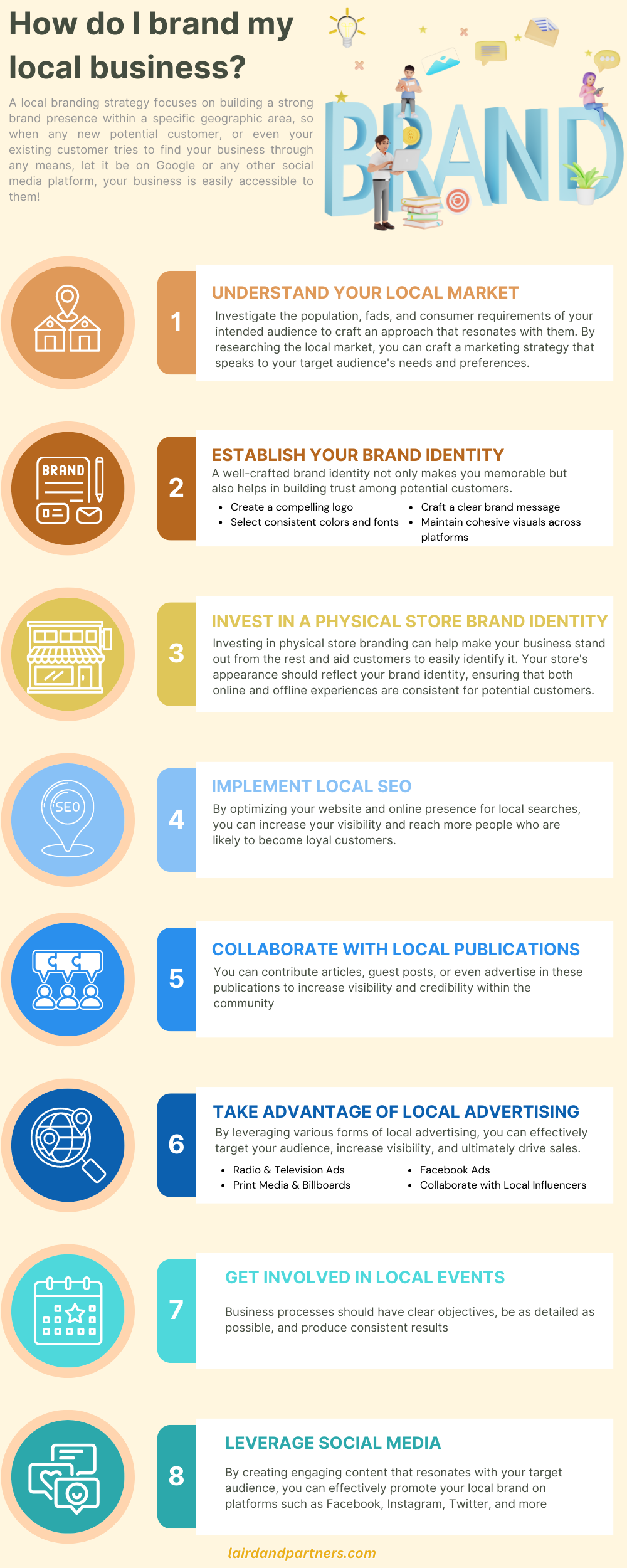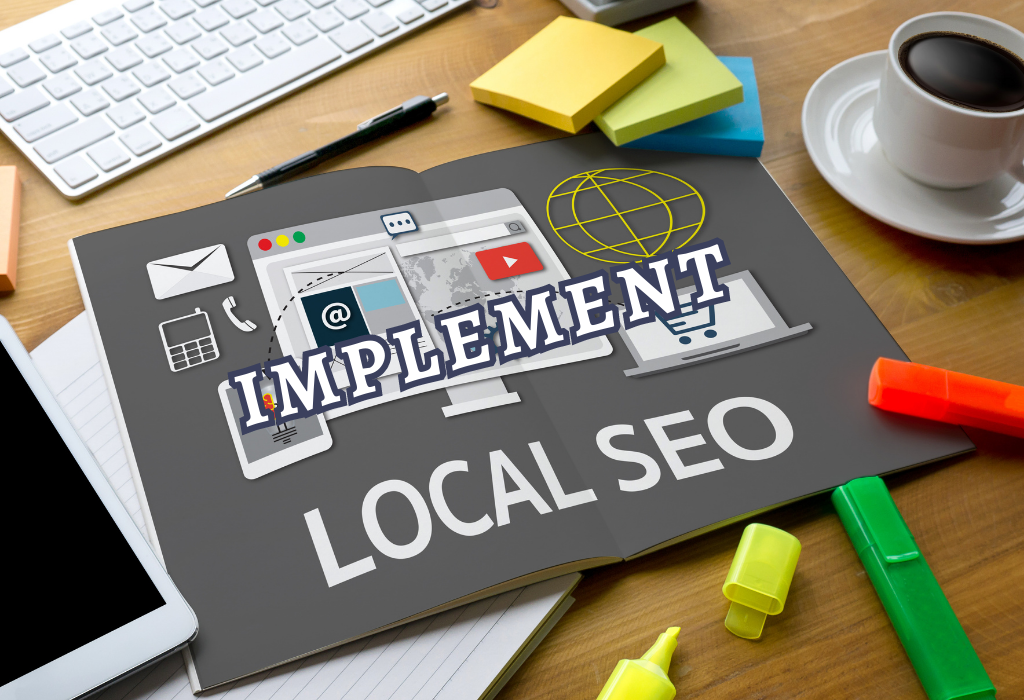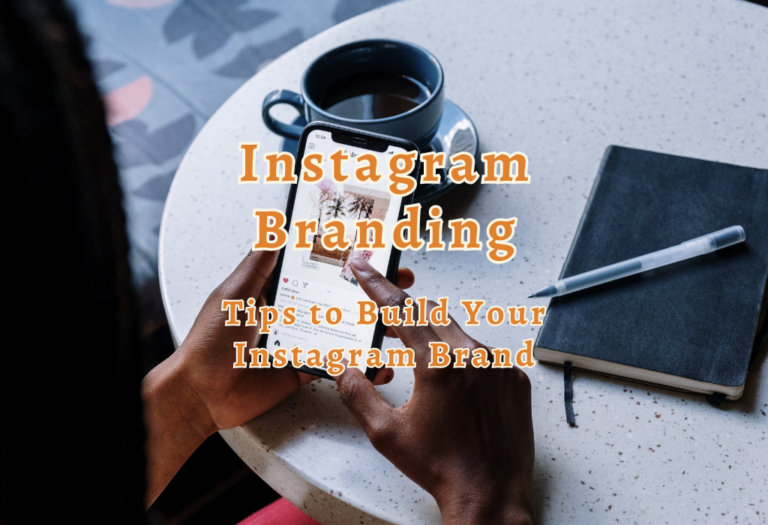Local Branding: Strategies for Your Business Success
As of the latest reports, 70% of customers shop locally to boost the local economy and 64% of them use Google Business Profile to contact a local business!
Now what if your local brand doesn’t even have a good optimized Google Business Profile?
Will your customers be able to contact you?
Obviously, Not!
Here is where local branding comes into play!
A local branding strategy focuses on building a strong brand presence within a specific geographic area, so when any new potential customer, or even your existing customer tries to find your business through any means, let it be on Google or any other social media platform, your business is easily accessible to them!
Local branding offers a lot of advantages for your local business, such as increased customer loyalty, improved visibility within the community, enhanced reputation for being locally-focused, better targeting of advertising efforts, and stronger relationships with other businesses in the area! These benefits ultimately lead to higher sales conversions and long-term growth.

More Resources :
How do I brand my local business?

To brand your local business effectively, follow these steps:
1. Understand Your Local Market
Knowing your local market is essential for successful local branding.
Investigate the population, fads, and consumer requirements of your intended audience to craft an approach that resonates with them. By researching the local market, you can craft a marketing strategy that speaks to your target audience’s needs and preferences.
A. Conduct Market Research
To get started, conduct thorough market research by gathering data on consumer preferences, competitor analysis, and industry trends within your region. This information can be obtained through surveys, focus groups, or online resources such as census data.
B. Identify Your Target Audience
Determine who makes up your target audience based on factors like age group, income level, interests, or occupation type among others. Once you have identified these key segments of consumers in the local market, it becomes easier to craft a compelling brand message that speaks directly to their needs.
i) Create Buyer Personas:
ii) Analyze Competitors:
Understanding your local market helps you create a successful brand that appeals to the specific needs of consumers in the area while setting yourself apart from competitors. Conduct thorough research, identify target audience segments & optimize marketing efforts accordingly to ensure maximum impact and engagement with potential customers locally.
2. Establish Your Brand Identity
Developing a unique and strong brand identity is crucial for your local business to stand out from the competition and resonate with your target audience. A well-crafted brand identity not only makes you memorable but also helps in building trust among potential customers. Here are some key elements to consider when establishing your brand identity:
Create a compelling logo
Your logo should be visually appealing, easy to recognize, and reflect the essence of your business. Consider hiring a professional designer or using an online tool like Canva to create an impactful logo.
Select consistent colors and fonts
Choose colors that represent the personality of your brand, evoke emotions related to it, and ensure they’re consistent across all marketing materials. Similarly, select typography that complements your visual elements while being legible on various platforms.
Craft a clear brand message
Communicate what sets you apart from competitors through concise messaging that highlights the benefits of choosing your products or services over others’. Use this messaging consistently throughout all communication channels such as websites, social media posts, and ads, so potential customers can easily understand what you offer.
Maintain cohesive visuals across platforms
Ensure consistency in design elements like images or graphics used on different mediums (online and offline) for creating familiarity among users who interact with multiple touchpoints during their customer journey.
In addition to these components of branding mentioned above, working with an experienced branding agency like LairdandPartners can help you create a cohesive and impactful brand identity that resonates with your local audience.
Developing Brand Guidelines
To ensure consistency in your branding efforts, it’s essential to develop brand guidelines. Outlining the correct utilization of logos, colors, fonts, images and other visual components is essential for maintaining brand consistency. They also serve as a reference for employees or external partners when creating marketing materials.
Creating a unique brand identity through creative marketing strategies can help ensure your business stands out from the competition. Going ahead, it’s important to ponder how putting resources into a physical store brand identity can help propel your organization forward.
3. Invest in a Physical Store Brand Identity
Investing in physical store branding can help make your business stand out from the rest and aid customers to easily identify it. Your store’s appearance should reflect your brand identity, ensuring that both online and offline experiences are consistent for potential customers. Consider investing in signage, window displays, and other visual elements that will draw attention to your store.
Create Eye-Catching Signage
Your storefront sign is often the first impression people have of your business, so make sure it reflects your brand message effectively. Choose colors, fonts, and materials that align with your brand guidelines. Additionally, consider using illuminated signs or unique shapes to catch the eye of passersby.
Design Engaging Window Displays
A well-designed window display not only showcases products but also tells a story about what makes your brand special. Use props, lighting effects, and creative arrangements to create an engaging scene that draws potential customers into the store. Rotate these displays regularly based on seasons or promotions to keep things fresh.
Incorporate In-Store Visuals Consistently
Invest in Staff Uniforms and Training
Your employees are the face of your brand, so it’s essential to invest in their appearance and training. Provide uniforms that align with your brand colors and style, ensuring they present a professional image. Additionally, train staff on how to communicate your brand voice effectively when interacting with customers.
By investing time and resources into developing an appealing storefront presence, you can increase foot traffic and ultimately drive more sales from potential customers within your local market.
To further enhance your branding efforts, you should consider doing Local Seo on your business website.
4. Implement Local SEO
By optimizing your website and online presence for local searches, you can increase your visibility and reach more people who are likely to become loyal customers. Here are some key tips to implement local SEO on your website:

Design A Mobile-Friendly and Attractive Website
Your website is the face of your business online, so it’s crucial that it looks professional and attractive. A mobile-friendly design is also necessary since most users access websites on their phones or tablets. Make sure that all images are optimized for web use, load quickly, and have high-quality resolution.
Improve Your Website Load Speed
No one likes a slow-loading website; this could lead to higher bounce rates which negatively impact user experience (UX) as well as search engine rankings. Use tools like Google PageSpeed Insights or GTmetrix to check how fast your site loads and identify areas where improvements can be made.
Implement On-Page SEO Targeting Localized Keywords
Build Citations in Local Directories Related To Your Niche
Optimize Your Google Business Profile
Your Google Business profile provides information about your company that appears when people search for it on Google. Optimize this by filling out all relevant fields with accurate information such as hours of operation, address and phone number. Also, encourage your customers to leave reviews on your profile, which will boost your visibility even further!
Link Building With High-Authority Websites In Your Niche And Local Area
Localize Content And Incorporate Your Focus Keywords And Is Of Interest To Your Audience:
Create content that resonates with the interests of potential customers in your area while incorporating focus keywords naturally into sentences. This could be blog posts, videos or social media updates – whatever format works best for you! Make sure it’s shareable too so others can spread the word about what makes YOUR brand unique!
5. Collaborate With Local Publications
To reach more potential customers, consider collaborating with local publications such as newspapers, magazines, or online platforms that cater to your target audience. You can contribute articles, guest posts, or even advertise in these publications to increase visibility and credibility within the community.
Incorporating external tools and regional media into your marketing approach can not only heighten brand visibility but also construct faith among prospective buyers. By strategically positioning yourself on these platforms, you can effectively reach more people who are actively searching for businesses like yours in the local market.
6. Take Advantage of Local Advertising
By leveraging various forms of local advertising, you can effectively target your audience, increase visibility, and ultimately drive sales.
A. Radio & Television Ads
Local radio stations and television networks offer prime opportunities for businesses to connect with nearby audiences. These traditional methods still hold value today, as they allow you to tailor your message specifically for the people living in your community. Craft your advertisements to be captivating and pertinent to the preferences of your intended audience.
B. Print Media & Billboards
In addition to radio and television spots, print media such as newspapers or magazines can be an effective way to promote your business locally. Consider placing advertisements in publications that cater directly to your desired customer base or running sponsored content pieces showcasing what sets you apart from competitors.
C. Facebook Ads
Utilize Facebook’s robust targeting options to reach potential customers in your area. Advertise locally and reach the desired demographic by utilizing geo-targeted campaigns.
D. Collaborate with Local Influencers
In today’s digital age, partnering with influencers who have a strong following within their community can be an effective way to increase brand awareness locally. Research popular bloggers or social media personalities in your area whose target audience aligns well with yours, then collaborate on sponsored posts or product reviews to showcase what makes your business unique.
Taking advantage of local ad options can help construct a recognizable brand identity and facilitate better communication with potential customers in the areas they inhabit.
7. Get Involved in Local Events
Attending regional activities is an excellent way to create connections with potential customers and enhance brand recognition in the area. By sponsoring events or hosting workshops related to your business’s products or services, you can maximize exposure and create positive associations with your brand.

Sponsorship Opportunities
Local events often provide sponsorship opportunities for businesses looking to gain visibility and establish themselves as supporters of their communities. This could include sponsoring a sports team, charity event, or cultural festival. When selecting an event to sponsor, consider how it aligns with your brand message, values, and target audience.
Host Workshops & Seminars
In addition to sponsorships, hosting workshops or seminars related to your industry can help position you as an expert in the field while providing valuable information that attracts potential customers. Topics should be relevant both locally and within the context of what you offer; this will ensure attendees are genuinely interested in learning more about how they might benefit from engaging with your business.
Networking Opportunities
Beyond sponsorships and workshops, attending networking events is another effective way of building relationships with potential customers while increasing brand visibility. Local business associations often host mixers or conferences where entrepreneurs can connect and share ideas. By actively participating in these gatherings, you’ll have the opportunity to showcase your expertise while forging connections that could lead to future collaborations or referrals.
8. Leverage Social Media
By creating engaging content that resonates with your target audience, you can effectively promote your local brand on platforms such as Facebook, Instagram, Twitter, and more.
A. Identify the Right Platforms for Your Business
To ensure your social media marketing efforts are effective, you must select the platforms most frequented by your target audience. For example, if you’re targeting a younger demographic, consider focusing on Instagram or TikTok instead of traditional methods like Facebook ads.
B. Develop a Consistent Brand Voice and Messaging Strategy
Establishing a consistent brand voice across all social media channels will help reinforce your overall brand message and identity in the minds of potential customers. This includes using a similar tone, language style, imagery, colors, fonts – everything that contributes to making up what people perceive as “your brand.”
C. Engage With Your Local Audience
Building relationships with your local audience is crucial for successful social media marketing. Quickly respond to any comments, messages, or reviews you receive and don’t be hesitant to get involved in discussions or pose queries that invite engagement.
Get More Local Leads With Us Today!
If you want to take your local branding efforts to the next level and work with the top class marketing experts, feel free to contact LairdandPartners!
We have 15+ years of experience helping businesses establish their unique voice while creating powerful messaging that drives results.






